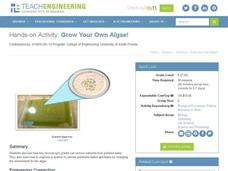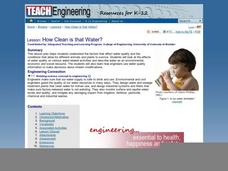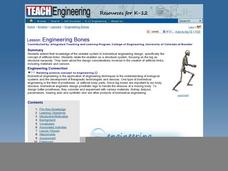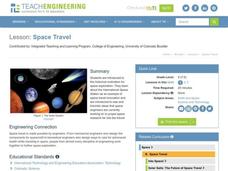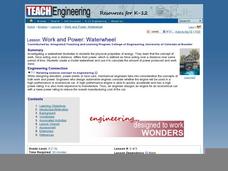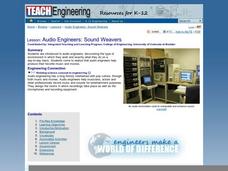Curated OER
It's Your Future
Students learn about productive resources along with their requirements, supply and demand, savings, investments and interest rates. In this supply and demand lesson, students create a career plan and personal budget of their own and...
Curated OER
The REAL Cost of College
Students explore the cost of college and how to plan and save. In this money management lesson students do research on the cost of college, learn about making financial choices, earning, spending, saving, investing and how they apply to...
Curated OER
It's Your Future!
Young scholars explore the concept of getting a job and buying a home. In this getting a job and buying a home instructional activity, students research job qualifications and salaries for various jobs. Young scholars discuss what is a...
Curated OER
Watershed Model
Students view a presentation of water and land and how we need to protect our water resources. In this water lesson plan, students discuss how we rely on water, and complete activities in all subjects related to water.
Curated OER
Slope Right Up
Learners use triangles to find the length and slope of each side. After connecting the vertices, they add points based on their specific instructions. They use the Pythagorean Theorem to complete a worksheet to end the lesson.
Curated OER
Getting it Right! An Investigation of the Pythagorean Theorem
In order to learn about the Pythagorean Theorem, young mathematicians investigate relations and patterns between different sides of a right triangle to look for possible relations among the squared sides. Once they have established the...
Curated OER
Rap Your Way Through Integers
Your resource or special education class will have fun with this interesting approach to learning about integers. They use rap, movement, and an interactive online game to reinforce the rules of integers. A well-rounded lesson that...
Beyond Benign
Ecological Footprint
How does your lifestyle measure up in terms of your ecological footprint? Young ecologists examine their impact on the planet using an insightful online calculator. A short quiz asks users to rank the size of their homes, their energy...
Teach Engineering
Grow Your Own Algae!
Develop a model of a wastewater treatment center. The last activity of the unit has pupils mix a lake water sample into a tank of water containing fertilizers. Over time, the algae from the lake water grows and removes the nutrient-rich...
Curated OER
Whispers of Angels: Buffalo and the Underground Railroad
What role did Buffalo, New York play in the Underground Railroad? Young historians investigate the Underground Railroad ties to Buffalo and western New York. They create a web site or multimedia presentation based on the research. If...
IOP Institute of Physics
Physics in Concert
What do physicists and musicians have in common? A lot more than you might think. After first viewing a slide show presentation and completing a series of skills practice worksheets on the physics of light, sound, and...
Curated OER
We've Come a Long Way, Baby!
Students study technology and the different reproductive technologies available today. In this human reproductive technology lesson students describe how engineers create technologies to improve the health of mothers and babies.
Curated OER
How Clean is the Water?
Students read about and discuss water and how it is used as a resource and how engineers use technology to preserve it. In this water lesson plan, students look at a picture of water treatment and tell what is wrong with the picture.
Teach Engineering
Wimpy Radar Antenna
The Diary of a Wimpy Antenna? In the last installment of a six-part series, your class constructs a model of a radio antenna and tests its torque. Pupils use the results to design a better model that resists bending and twisting forces.
Curated OER
Circulation
Students define the functions of the circulatory system. In this body circulation instructional activity students see how engineers have involvement with the circulatory system.
Curated OER
Asteroids
Students study asteroids and how their size relates to a possible danger of one colliding with Earth. In this asteroids lesson students see how big an asteroid has to be to cause destruction to Earth.
Curated OER
Digestion Simulation
Learners study the human digestion system and the functions of the stomach and small intestines. In this digestion lesson students view a demonstration on the process.
Curated OER
Engineering Bones
Pupils identify the features of a prosthetic limb and explain how engineers are involved in the prosthetic design. In this bone engineering lesson students describe the design criteria that goes into choosing the materials that go...
Curated OER
Team Apollo
Seventh graders brainstorm about problems with a school track. They research different possibilities for a solution. They test different track materials with erosion, durability, abrasiveness and resiliency. They determine the area,...
Curated OER
Making & Breaking : The Rock Cycle
Students examine the rock cycle and how rocks can change over time. In this geotechnical engineering lesson students draw a diagram of the rock cycle.
Curated OER
Space Travel
Students study the International Space Station and space exploration. In this space travel instructional activity students describe the different types of engineers that contribute to space travel.
Curated OER
Work and Power: Waterwheel
Students investigate a waterwheel and the physical properties of energy. In this waterwheel lesson students create a model waterwheel and calculate the amount of power produced.
Curated OER
Audio Engineers: Sound Weavers
Students explore audio engineering. For this career education and "sound" science lesson, students define related vocabulary and make connections between the music they listen to and the job an audio engineer does after listening to...
Curated OER
Breathe In, Breathe Out
Students study the respiratory system, the lungs and air. In this respiratory instructional activity students describe technologies that engineers have found that improve the health of the respiratory system.








